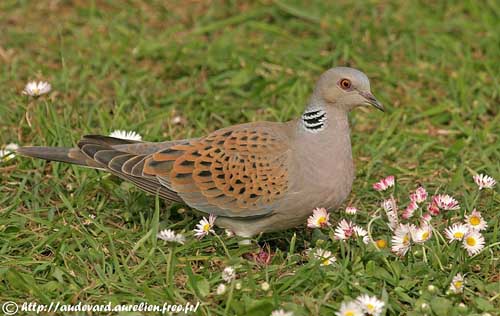
European Turtle-Dove
Streptopelia turtur
Columbiforme Order – Columbidae Family
BIOMETRICS:
Length: 27-29 cm
Weight: 100-170 g
DESCRIPTION:
European Turtle-Dove is a migratory species. We can see this lovely dove in spring and summer in Europe. Its plumage is more contrasted than in Eurasian Collared Dove, and this bird is very secretive and shy, living more in forested areas than in urban parks.
Fr: Tourterelle des bois
All : Turteltaube
Esp : Tórtola Europea
Ital : Tortora europea
Nd: Tortelduif
Russe: Обыкновенная горлица
Sd: Turturduva
Photographers:
Aurélien Audevard
OUESSANT DIGISCOPING
José Luís Beamonte
Pájaros de España
Didier Buysse
Vision d’Oiseaux
Jean Michel Peers
JMPN PHOTOGRAPHIE
Jean Marc Rabby
Des Ailes et des Plumes
Nicole Bouglouan
PHOTOGRAPHIC RAMBLE
Texte de Nicole Bouglouan
Sources:
HANDBOOK OF THE BIRDS OF THE WORLD vol 4 by Josep del Hoyo-Andrew Elliott-Jordi Sargatal - Lynx Edicions - ISBN: 8487334229
PIGEONS AND DOVES by David Gibbs, Eustace Barnes and John Cox - Pica Press Sussex - ISBN: 1873403607
ENCYCLOPEDIE DES OISEAUX DE FRANCE ET D’EUROPE – de Peter Hayman et Rob Hume - Flammarion – ISBN : 2082009920
THE HANDBOOK OF BIRD IDENTIFICATION FOR EUROPE AND THE WESTERN PALEARCTIC by Mark Beaman, Steve Madge - C.Helm - ISBN: 0713639601
Pájaros de España (JL Beamonte)

Adult male has greyish-brown scaled mantle. Rump and lower back are tinged blue-grey. Upperwing shows conspicuous scaled effect on inner wing coverts and scapulars of which each dark feather is broadly edged orange-buff, involving bold spotted pattern. Flight feathers are dark grey to blackish, finely bordered whitish. Uppertail coverts and central rectrices are greyish. Outer rectrices are darker with white terminal bar and white outer webs on the outermost tail feathers.
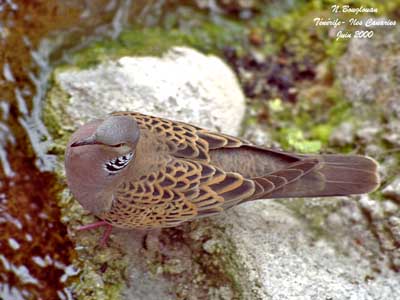
On the underparts, upper throat is white whereas lower part and breast are mauve-pink, blending into white belly and undertail coverts. Flanks are pale grey. Underwing is bluish-grey. Undertail is black and white.
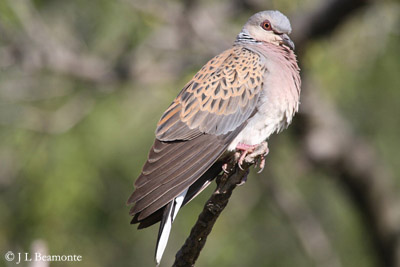
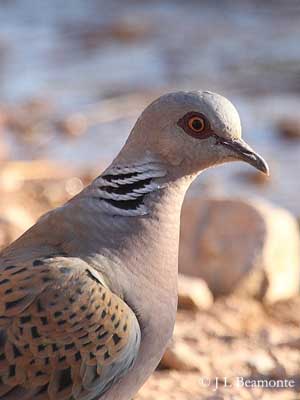
On the head, forehead is pale bluish-grey, darker in crown, nape and hind neck. We can see some black and white lines on neck sides and rear neck forming a patch.
Bill is blackish. Eyes are pale orange surrounded by broad, bare dark pinkish eye-ring. Legs and feet are pinkish.
Female is similar to male. She may be slightly paler and duller.
Juvenile is duller and browner than adults, with buff-tipped feathers. Neck patch is absent on only marked by grey area.
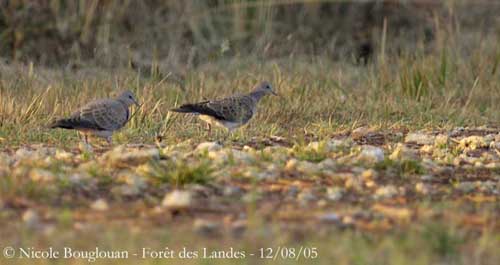
We find four subspecies which differ in size and intensity of colours.
The European Turtle-Dove here displayed (below) is the subspecies arenicola from North Africa, Middle-East and Asia. She is usually slightly paler and smaller than nominate race. The underparts show less mauve-pink and are whiter.
However, this one intergrades widely with nominate race and other subspecies hogarra, also present in North Africa, giving numerous birds difficult to differentiate.
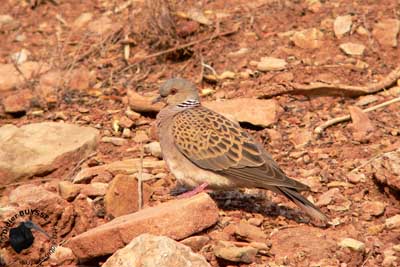

VOICE: SOUNDS BY XENO-CANTO
European Turtle-Dove utters a deep purring “tuooorr-tuooorr-tuooorr” soft and monotonous. Each phrase is repeated 3-4 times with short intervals.
During courtship displays, male utters a hurried “croor” while bobbing the head. When excited, it produces a popping noise.
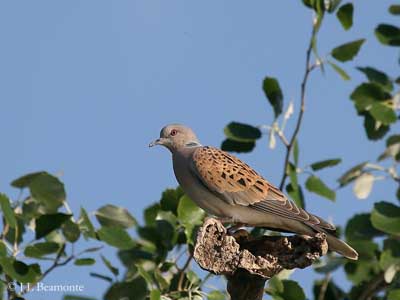
HABITAT:
European Turtle-Dove frequents a wide variety of woodlands with open grounds and wooded or shrubby shelter, steppe and semi-desert and mainly woodland edges. This species avoids wet and windy regions, preferring dry, sunny and sheltered areas. It is a lowland species rarely seen up to 500 metres of elevation, but in the southern parts of the range, it may occur up to 1000-1500 metres.
On the African wintering grounds, it frequents Acacia and Combretum savannahs, but also coastal Sueda bush.
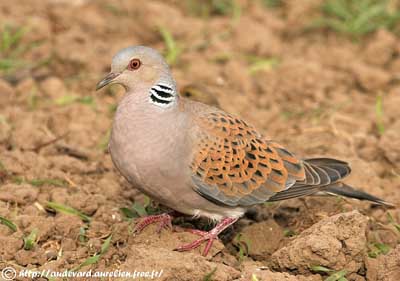
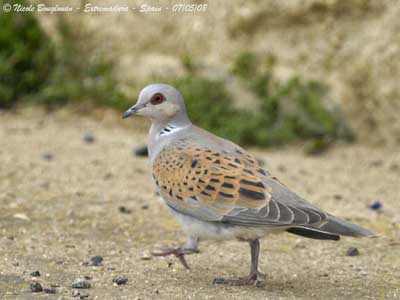
RANGE:
European Turtle-Dove ranges across most of continental Europe, except in Ireland, Scotland and Denmark where the species is rare or local. It extends into Russia to N and C China and SW Mongolia. It is also present in North Africa and on the largest Mediterranean islands and in Canary Islands.
The Saharan populations are resident, whereas the migratory birds winter in a wide area across Sahelian Africa, from S Mauritania to W Ethiopia.
Eastern races winter in NW India.
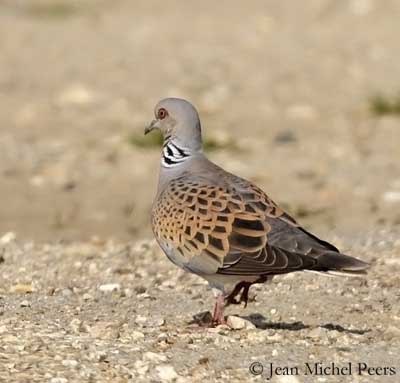
BEHAVIOUR:
European Turtle-Dove feeds mainly on seeds and fruits of weeds and cereals. Some berries and fungi may be sometimes eaten. It also takes insects and pupae, earthworms and snails. This bird feeds mainly on the ground, although being largely arboreal.
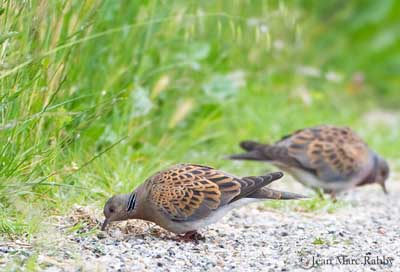
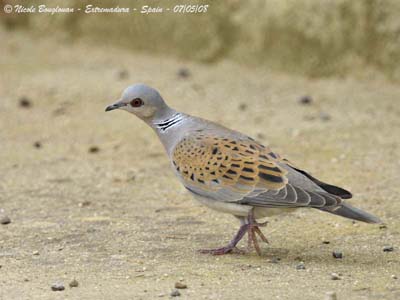
European Turtle-Dove is usually solitary or in pairs on the breeding grounds, but numerous birds can gather at abundant food sources.
This species is very gregarious outside breeding season and flocks of thousands can be seen at drinking sites in Africa.
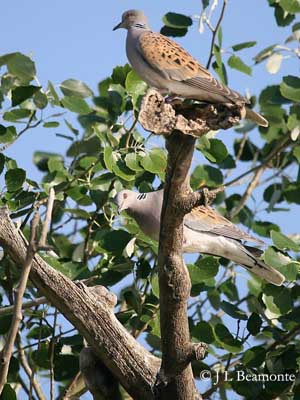
During the breeding season, they perform courtship displays similar to other Streptopelia. During the flight display, the male rises from its singing perch and glides back in a wide arc with extended wings forwards and fanned tail.
The bowing displays occur on high branch and close to the female, or on the ground. The male bobs rapidly with neck feathers erected as a ruff on head sides, in order to display the black and white neck pattern.
In front of predator approaching the nest, adults respond by performing the “broken-wing” display, and try to lead the intruder away from the nest-site.
FLIGHT:
European Turtle-Dove has relatively large and broad wings giving great manoeuvrability in flight, and the long tail allows quick changes of direction and good landing.
It is able to reach speeds of 95 km per hour.
REPRODUCTION:
Breeding season starts in May in Europe.
As in Columbidae, the nest of the European Turtle-Dove is a loose platform of twigs. The interior is lined with softer materials such as grass, roots and leaves. It is placed in tree or shrub, at about 2-3 metres above the ground.
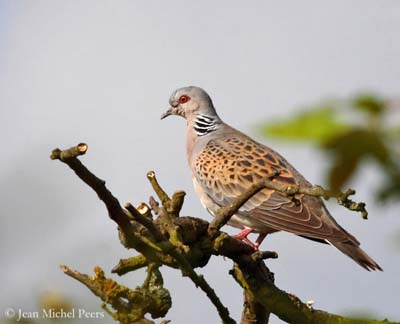

Female lays two white eggs. Both sexes incubate during two weeks. Young fledge 20 days after hatching. They can breed at one year.
This species produces two broods per year, sometimes three.
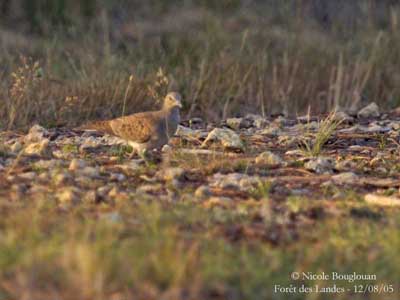
DIET:
European Turtle-Dove feeds on seeds and fruits of weeds and cereals. Seeds are taken from several plant species such as Brassica, Furnaria, Helianthus… Seeds of Setaria are primarily eaten.
It also consumes berries and fungi occasionally, and insects, pupae, earthworms and snails. This species feeds mainly on the ground.
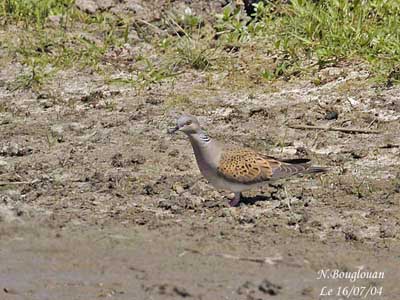
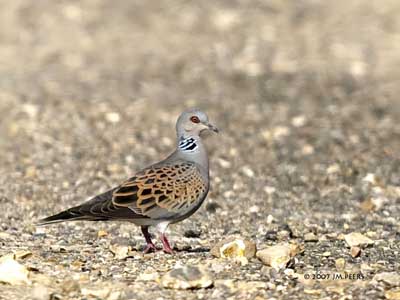
PROTECTION / THREATS / STATUS:
European Turtle-Dove is widespread and fairly common in most parts of the range. However, local populations have decreased, due to changes in the habitat with destruction of hedges and transformation of cultivated areas. Hunting is a major threat for migrating birds, both during migrations and on wintering grounds.
The use of herbicides is also an important factor of declines with destruction of numerous food plants.
The species is not globally threatened at this moment, but it is less common than in the past.
